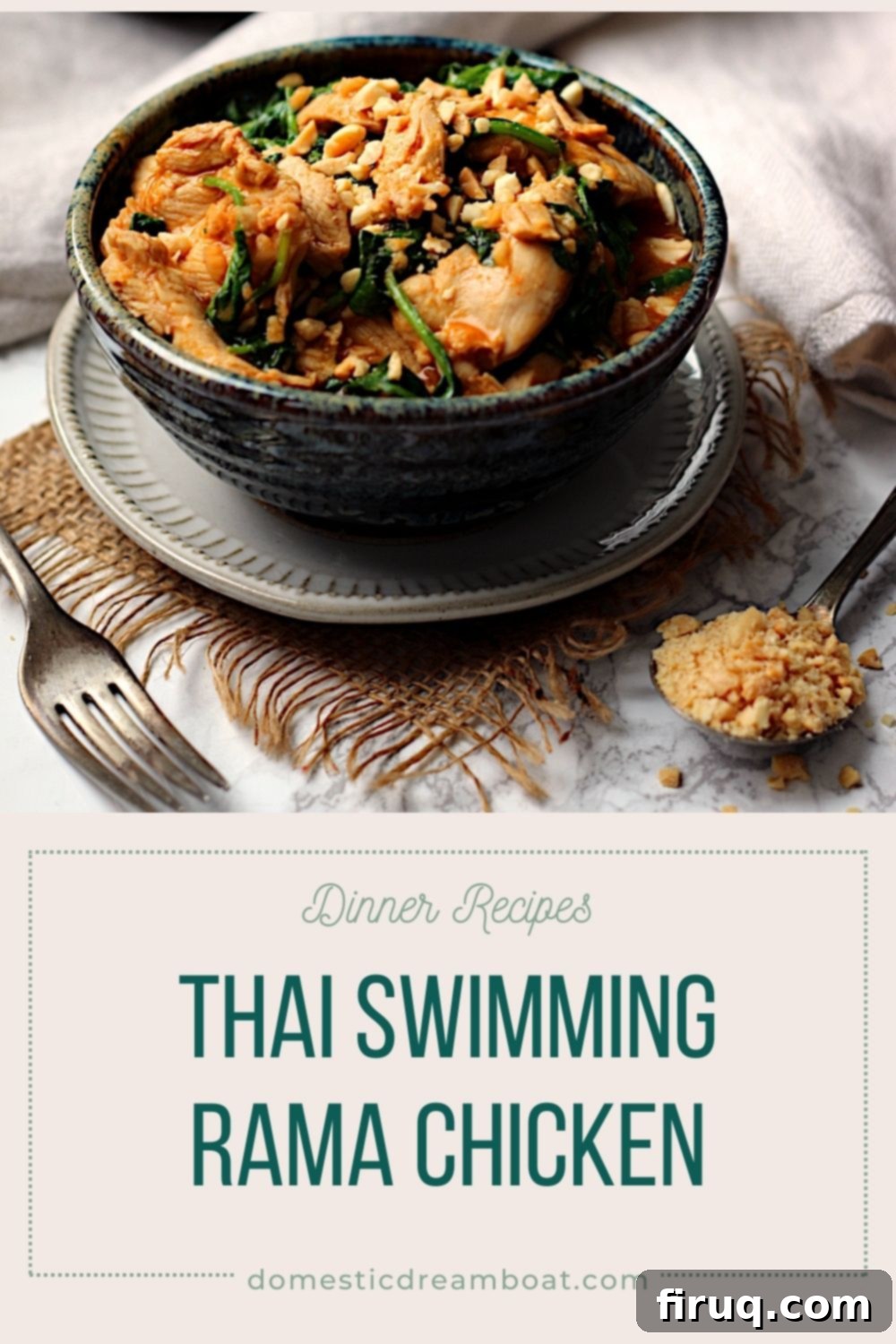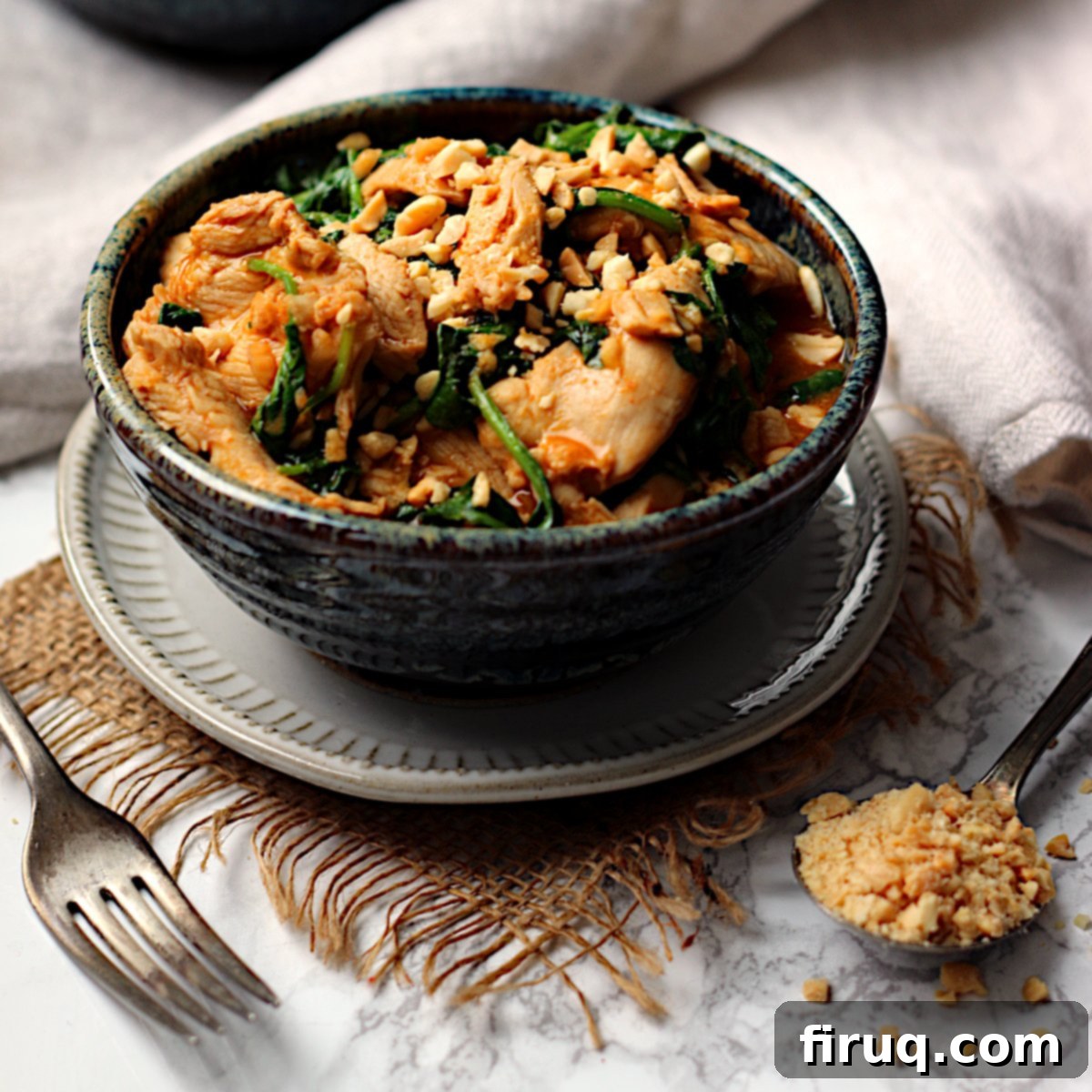Authentic Thai Swimming Rama Chicken: Creamy Peanut Curry with Spinach (Easy Recipe)
Dive into the rich and vibrant flavors of Thailand with this incredible homemade Thai Swimming Rama Chicken recipe. Featuring succulent chicken and fresh spinach bathed in a luscious sauce made from red curry paste, creamy peanut butter, and decadent coconut milk, this dish delivers an authentic taste of Thai cuisine right to your kitchen. Best of all, it’s surprisingly easy to prepare and can be on your table in under an hour, making it perfect for a delicious weeknight meal or a special weekend treat.
My journey with Thai food began as a young adult, back in the early 2000s, during a memorable trip to Thailand with my family. We explored the bustling streets of Bangkok, relaxed on the pristine beaches of Phuket, and even embarked on a captivating island-hopping boat tour. It remains the furthest I’ve ever traveled, an experience filled with incredible sights, sounds, and, most importantly, unforgettable flavors. (We’ll conveniently gloss over the fact that it was during the SARS outbreak – some memories are better left edited!)
That trip sparked a lifelong love for Thai cuisine. Upon returning home, my family often sought out authentic Thai restaurants, and one particular gem in Calgary became our go-to spot. I was delighted to find that this restaurant, which left such a lasting impression, is still thriving today! Among the many exquisite dishes we enjoyed there, Thai Swimming Rama Chicken quickly became my absolute favorite. It was a comforting, stew-like curry, characterized by its rich peanut sauce and the freshness of wilted spinach, always perfectly complemented by a side of fragrant coconut rice. Recreating that beloved flavor at home seemed daunting at first, but I was pleasantly surprised by how simple and rewarding the process turned out to be.
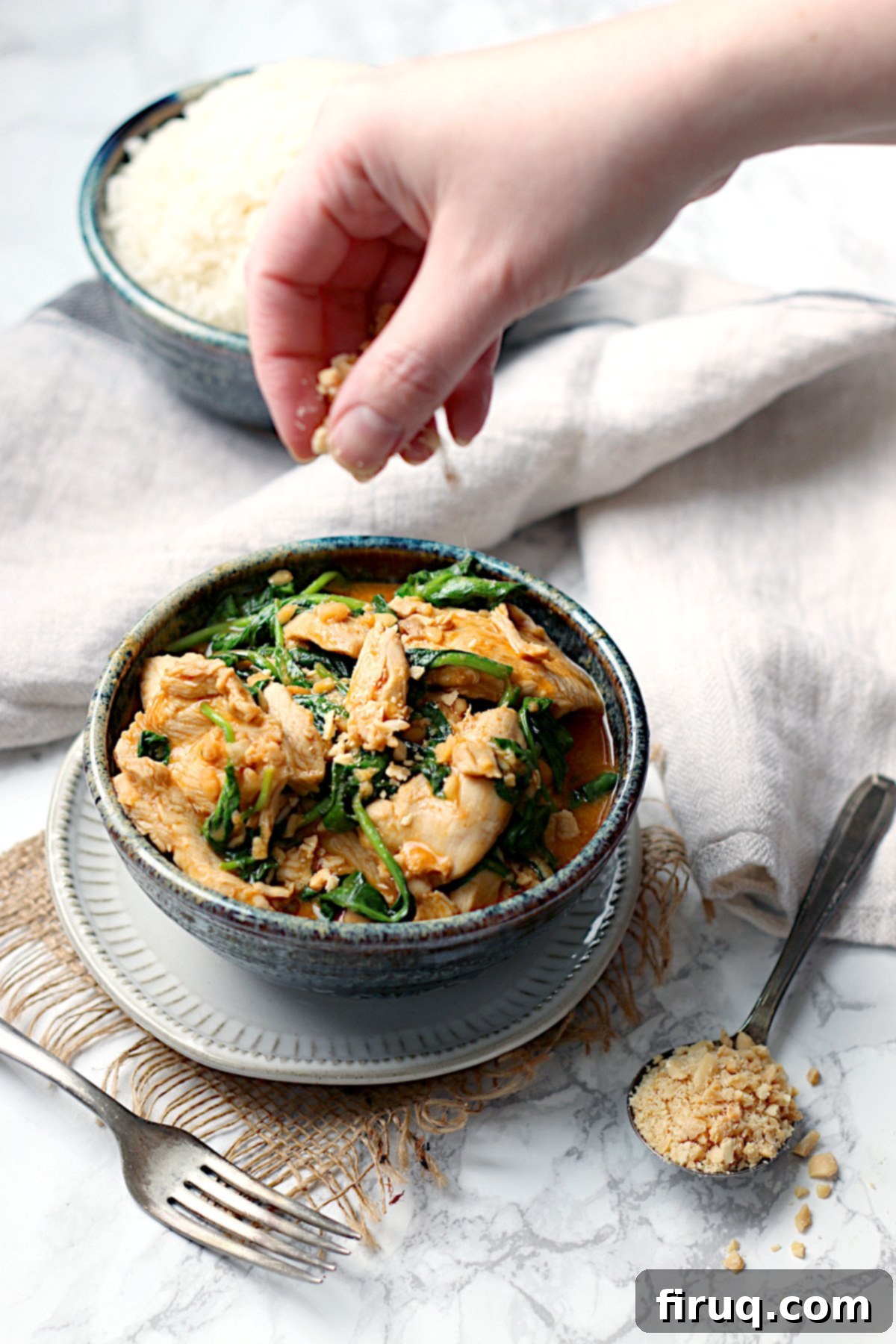
What is Thai Swimming Rama Chicken?
Thai Swimming Rama Chicken, known in Thailand as Phak Boong Loy Fa (literally “morning glory swimming in the sky,” referring to the spinach), or often simply a chicken and peanut curry, is a beloved dish celebrated for its unique blend of sweet, savory, and slightly spicy notes. It’s not as widely known as Pad Thai or Green Curry outside of Thailand, but once you try it, you’ll understand its appeal. The dish typically features tenderized chicken (often “velveted” for a silky texture) and blanched or wilted spinach, all enveloped in a thick, flavorful sauce. The sauce is the star, combining the aromatic complexity of red curry paste with the nutty richness of peanut butter and the creamy sweetness of coconut milk, balanced by a hint of fish sauce for umami depth. Traditionally, it’s served over steamed jasmine rice, allowing the rice to soak up every drop of that irresistible sauce.
How to Make Homemade Swimming Rama Chicken
Crafting Thai Swimming Rama Chicken from scratch is a straightforward process, and with most ingredients readily available at your local well-stocked grocery store, it’s an accessible culinary adventure. The key to success lies in proper preparation and understanding a few simple techniques.
1. Tenderizing the Chicken: The “Velveting” Technique
Our recipe begins with thinly sliced chicken, which we’ll marinate in a mixture of water, reduced-sodium soy sauce, and cornstarch. This technique, known as “velveting,” is a common practice in Asian cooking. It not only helps to tenderize the chicken, resulting in a wonderfully silky texture, but also creates a thin protective coating that prevents the chicken from drying out during cooking. Allow the chicken to marinate for about 10 minutes; this brief period is enough to achieve the desired effect.
2. Prepare Your Components (Mise en Place)
While the chicken marinates, take this opportunity to prepare the rest of your ingredients. This is crucial for Thai cooking, as many steps are quick and require your full attention. Mince your garlic, grate fresh ginger (a pro tip: keep ginger in your freezer and grate it directly from frozen for easy, consistent results!), chop the unsalted peanuts for garnish, and wash your baby spinach. If you’re serving with rice or noodles, get those cooking simultaneously to ensure everything is ready at the same time.
3. Cooking the Chicken to Perfection
Once your ingredients are prepped and the chicken has marinated, it’s time to cook. Heat about half of the cooking oil in a large skillet or sauté pan over medium-high heat. Add the marinated chicken, ensuring you leave any excess liquid behind in the bowl. Cook the chicken until it’s lightly browned and no longer pink. The velveting process will ensure it stays incredibly tender. Once cooked, transfer the chicken and any accumulated juices to a clean plate or bowl and set aside.
4. Building the Flavorful Peanut Curry Sauce
Wipe your skillet clean with a paper towel and return it to medium-high heat. Add the remaining cooking oil. Now, it’s time to build the aromatic base of your sauce. Add the minced garlic, grated ginger, and red curry paste to the pan. Sauté for about 30-60 seconds, stirring constantly, until the mixture becomes wonderfully fragrant and just barely begins to brown. This step is essential for awakening the spices and deepening the flavor of the curry paste. Next, stir in the light coconut milk, brown sugar (or your chosen sweetener), peanut butter, and fish sauce. Bring the mixture to a boil, then reduce the heat to a simmer. Allow it to cook for about 10 minutes, stirring frequently, until the sauce thickens to your desired consistency – a rich, creamy texture is ideal.
5. Combining and Finishing Touches
Once the sauce has thickened, return the cooked chicken and any juices from the bowl to the pan. Stir to coat the chicken thoroughly. Add about half to three-quarters of your chopped peanuts to the sauce, reserving some for garnish. Cook for another minute or two, allowing the chicken to absorb the sauce’s flavors. Finally, stir in the baby spinach. You might need to add it in batches if your pan is very full, as it wilts down quickly. Cook just until the spinach is tender and wilted, which usually takes about 2 minutes. Overcooking the spinach will diminish its vibrant color and delicate texture.
Serve your steaming hot Thai Swimming Rama Chicken generously over your choice of plain jasmine rice, fragrant coconut rice, or noodles. Finish each serving with a sprinkle of the remaining chopped peanuts for a delightful crunch and extra nutty flavor. Enjoy this authentic taste of Thailand!
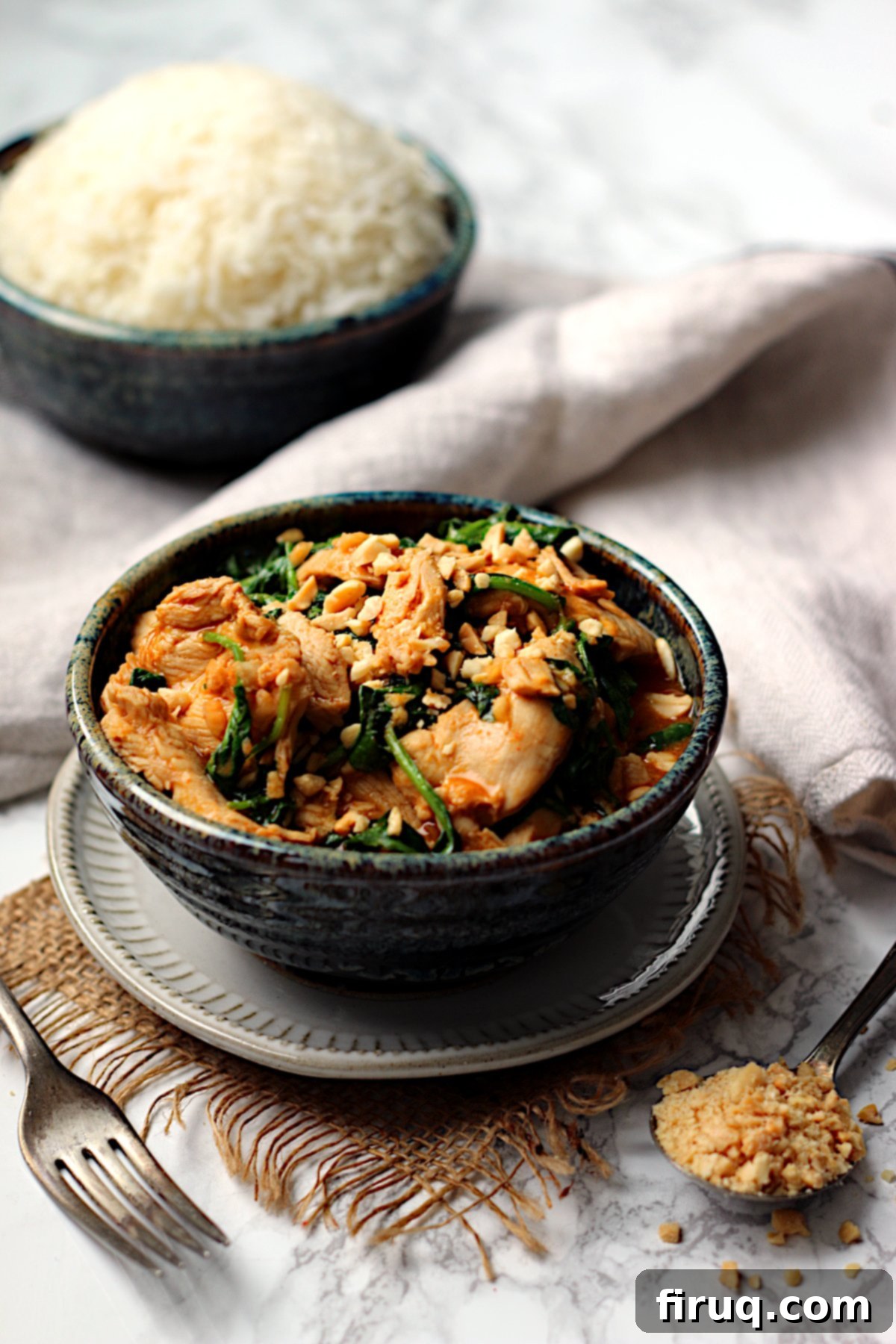
Essential Swimming Rama Chicken Ingredients & Pro Tips
The beauty of Thai Swimming Rama Chicken lies in its accessible yet impactful ingredients. Here’s a closer look at what you’ll need and some tips for selecting and preparing them:
- Boneless Skinless Chicken Breasts or Thighs: Both work beautifully. Thighs offer a slightly richer flavor and stay moister, while breasts are leaner. Ensure they are thinly sliced for quick and even cooking.
- Water: Regular tap water is perfectly fine for marinating and adjusting sauce consistency.
- Reduced-Sodium Soy Sauce: This helps control the overall saltiness of the dish. For a gluten-free version, easily substitute with tamari or a certified gluten-free soy sauce. Regular soy sauce can also be used if preferred.
- Cornstarch: A key component in the velveting process, it creates a light coating that tenderizes the chicken and prevents it from drying out.
- Canola Oil or Other Neutral-Flavored Cooking Oil: Oils like vegetable oil or grapeseed oil are also suitable. Avoid strong-flavored oils that might overpower the delicate curry notes.
- Grated Fresh Ginger: Fresh ginger provides a bright, pungent warmth. Pro tip: Always keep a knob of ginger in your freezer. It grates easily from frozen and means you always have fresh ginger on hand without it spoiling. Use a microplane for fine grating.
- Garlic: Freshly minced garlic is essential for that aromatic foundation.
- Red Curry Paste: This is the heart of the curry flavor. Look for it in the international aisle of well-stocked grocery stores or at Asian specialty markets. Brands like Mae Ploy or Thai Kitchen are commonly available. Adjust the amount to your preferred spice level.
- Light Coconut Milk: While light coconut milk is used in this recipe for a slightly less caloric option, full-fat coconut milk will yield an even richer, creamier sauce. Choose good quality unsweetened coconut milk.
- Brown Sugar: Adds a crucial touch of sweetness that balances the savory and spicy elements. You can substitute with palm sugar (traditional in Thai cooking), coconut sugar, or even granulated sugar if needed. Adjust to taste.
- Peanut Butter: Any type of smooth, unsweetened peanut butter will work. Natural peanut butter (just peanuts and salt) is often preferred for a cleaner flavor. It adds body and that signature nutty taste.
- Fish Sauce: A foundational ingredient in Thai cuisine, fish sauce provides a depth of savory, umami flavor. Don’t skip it!
- Unsalted Peanuts: Finely chopped, these add a delightful crunch and extra peanut flavor. If you only have salted peanuts, reduce or omit any added salt in the recipe, and make sure they don’t have any additional flavors or seasonings.
- Baby Spinach: Fresh baby spinach wilts quickly and adds a beautiful green color and subtle earthy note to the dish.
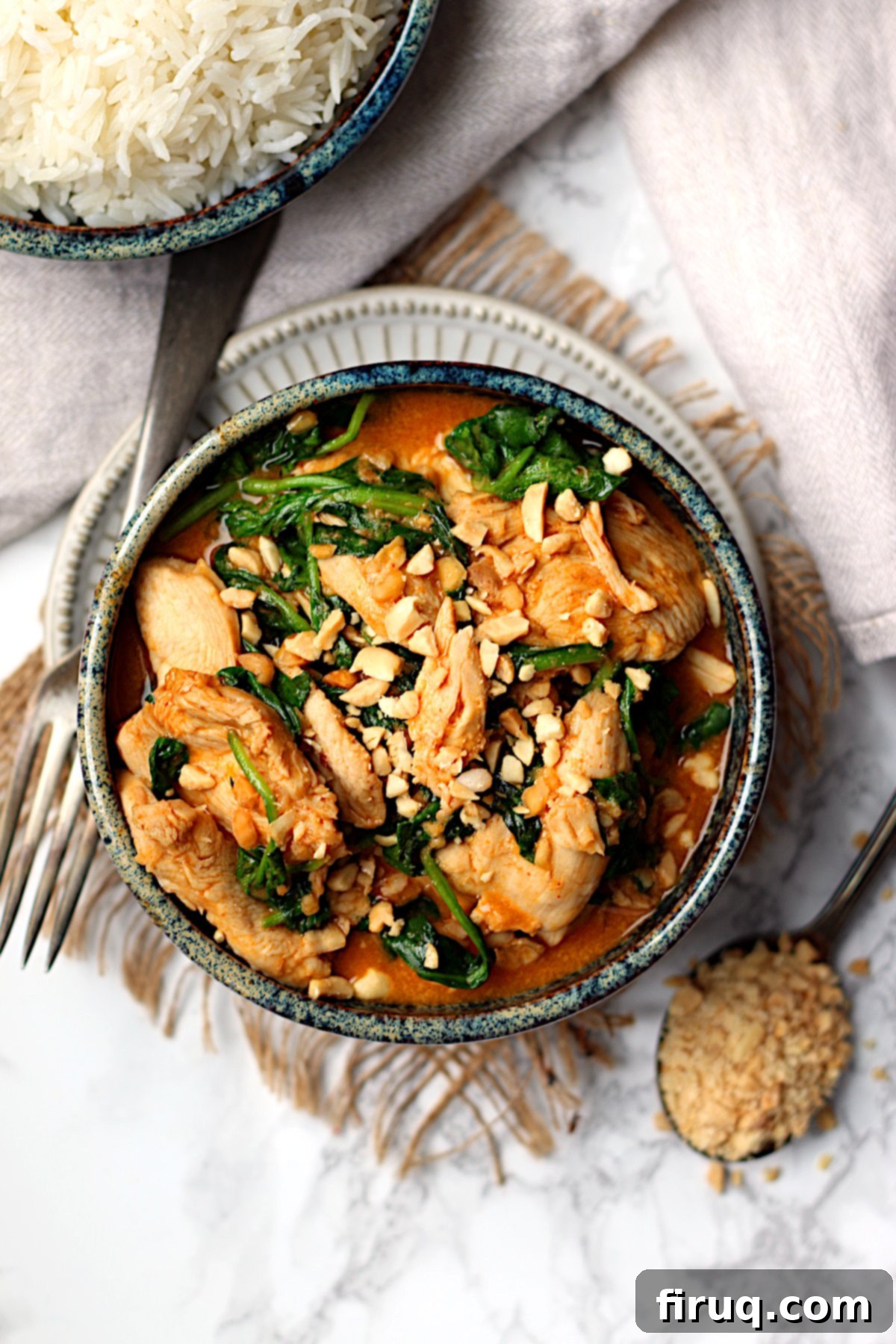
Swimming Rama Variations: Customizing Your Curry
One of the best aspects of home cooking is the flexibility to adapt recipes to your taste and dietary needs. Thai Swimming Rama is versatile, offering several delicious variations:
Shrimp Swimming Rama
If you prefer seafood, Thai Swimming Rama is also commonly made with shrimp. To create a delicious shrimp version, simply replace the chicken with an equal amount of peeled and deveined shrimp. Opt for large or jumbo shrimp for the best texture (ensure they are raw, not pre-cooked).
- Skip Marinating: Shrimp cook very quickly and don’t require the velveting step. Instead, season the raw shrimp with about 1/2 teaspoon of salt before cooking.
- Quick Cooking: When you cook the shrimp, heat the oil over medium-high heat and sauté them for only 1-2 minutes per side, or just until they turn from grey to pink. Overcooked shrimp become rubbery. Remove them from the skillet as soon as they are pink, then proceed with the rest of the recipe as written, adding the cooked shrimp back into the sauce at the same step you would add the chicken.
Vegetarian/Vegan Swimming Rama
Making this dish vegetarian or vegan is simple and equally delicious:
- Protein Substitute: Replace the chicken with firm or extra-firm tofu, tempeh, or even hearty vegetables like mushrooms or cauliflower florets.
- Tofu/Tempeh: Press the tofu to remove excess water, then cut into cubes or triangles. You can pan-fry or bake it until golden brown before adding it to the sauce. For tempeh, steam it briefly before pan-frying for a softer texture.
- Vegetables: Add vegetables like bell peppers, broccoli, green beans, or snap peas along with the spinach.
- Vegan Adjustment: To make it fully vegan, ensure your red curry paste does not contain shrimp paste (many popular brands offer vegan options, just check the label!). Replace fish sauce with a high-quality vegan fish sauce substitute (available in Asian markets) or simply use an equal amount of light soy sauce or tamari for umami, along with a squeeze of lime juice for brightness.
Adjusting Spice Levels
The heat level of this dish primarily comes from the red curry paste. You can easily adjust it to your preference:
- Milder: Start with just 1 tablespoon of red curry paste. You can always add a pinch of cayenne pepper or chili flakes at the end if you want more heat.
- Spicier: Increase the red curry paste to 3 tablespoons or more, depending on your heat tolerance. For an extra kick, add a sliced fresh bird’s eye chili or a dash of chili oil when serving.
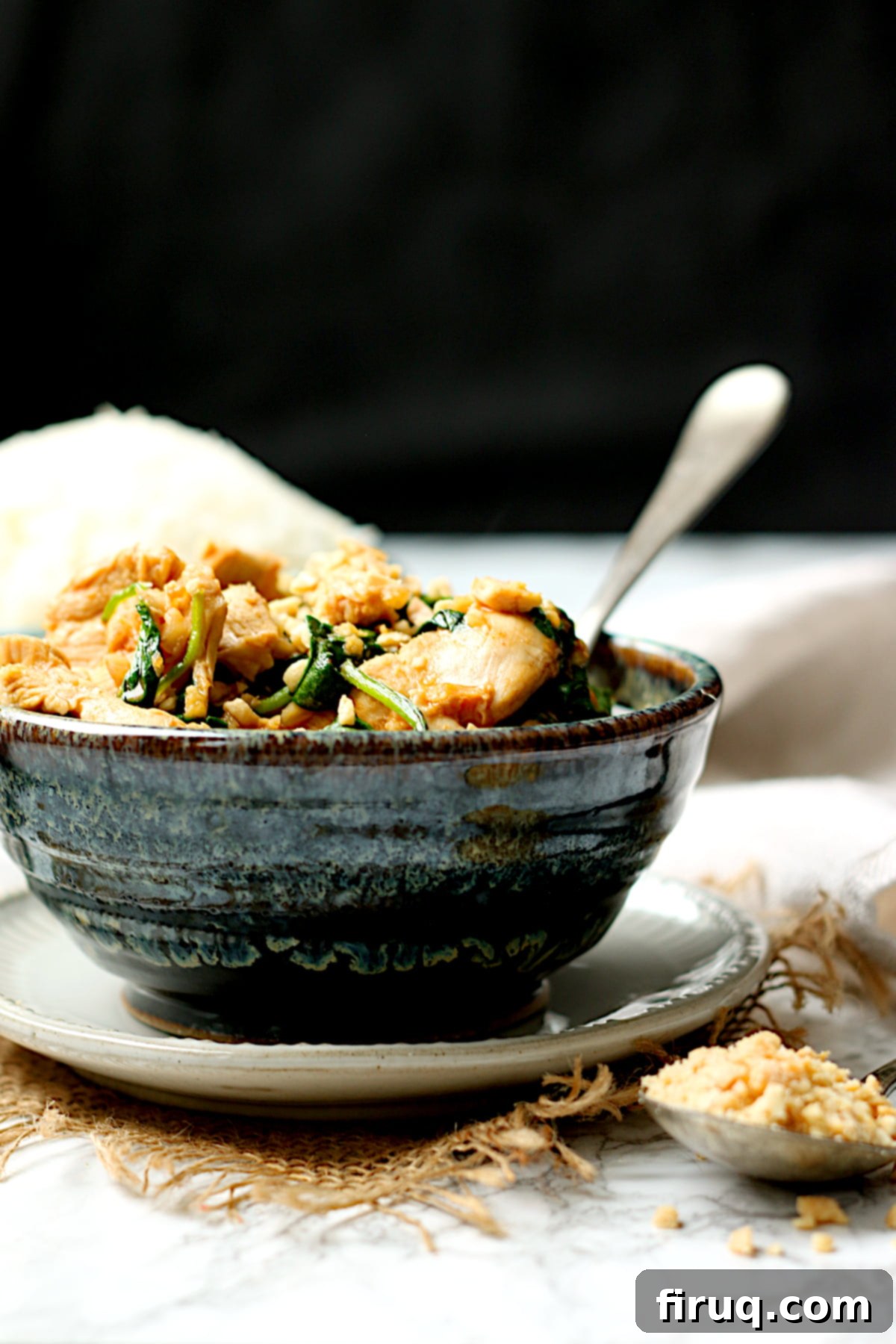
Tips for the Best Swimming Rama Chicken
To ensure your homemade Thai Swimming Rama Chicken turns out perfectly every time, keep these additional tips in mind:
- Don’t Skimp on Fresh Ingredients: While pre-made curry paste is a convenience, fresh ginger, garlic, and spinach make a significant difference in the final flavor and freshness of the dish.
- Taste and Adjust: Thai cuisine is all about balance. Before serving, taste the sauce and adjust the seasoning as needed. You might want a little more sweetness (brown sugar), more umami (fish sauce), or a touch more heat (red curry paste or chili flakes).
- Coconut Milk Quality: The quality of your coconut milk can affect the richness of the sauce. For the creamiest texture, use full-fat coconut milk. If using light, stir it well before opening the can to ensure consistent texture.
- Serving Suggestions: While rice or noodles are traditional, consider serving Swimming Rama Chicken over quinoa for a healthier grain option, or with cauliflower rice for a low-carb alternative. Steamed green beans or blanched broccoli can also be excellent additions.
- Storage and Reheating: Leftovers can be stored in an airtight container in the refrigerator for up to 3-4 days. Reheat gently on the stovetop over medium-low heat, adding a splash of water or coconut milk if the sauce has become too thick.
Want More Delicious Chicken Entrée Recipes?
Swimming Rama Chicken Nutrition Notes and Dietary Considerations
This Thai Swimming Rama Chicken recipe offers a balance of protein, healthy fats, and carbohydrates, especially when served with a grain. Here are a few important nutrition and dietary notes:
- Gluten-Free: To ensure this recipe is entirely gluten-free, remember to use tamari or a certified gluten-free soy sauce instead of regular soy sauce. Always check the label of your red curry paste as some brands may contain gluten-containing ingredients.
- Complete Meal: To make this a well-rounded and complete meal, serve your Swimming Rama Chicken with rice (jasmine, brown, or coconut), noodles, quinoa, or another cooked grain. Please note that the nutritional information provided in the recipe card below typically does not include these additional serving components.
- Calorie & Fat Content: The sauce is rich due to coconut milk and peanut butter. Using light coconut milk can slightly reduce the fat content, but full-fat offers a more decadent experience. Portion control is key for managing calorie intake.
- Sodium: Fish sauce and soy sauce contribute significantly to the sodium content. If you’re watching your sodium intake, opt for low-sodium soy sauce and use fish sauce judiciously. Taste and adjust before adding more.
- Fiber & Vitamins: The generous amount of baby spinach adds a good dose of fiber, Vitamin A, and Vitamin C, boosting the nutritional value of the dish.
Thai Swimming Rama Chicken (Chicken and Spinach in Peanut Sauce)
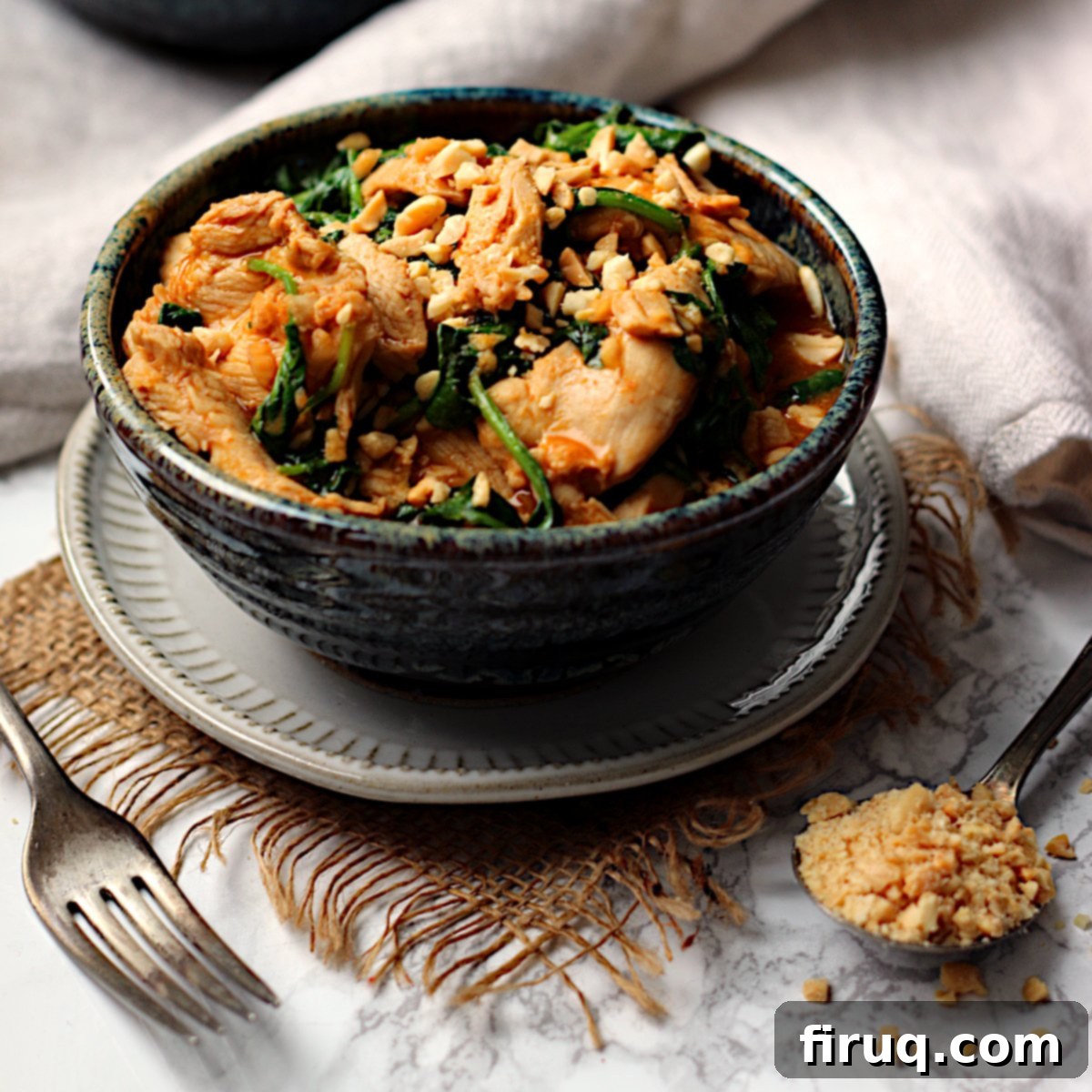
Print Recipe
Pin Recipe
Equipment
-
Microplane
-
Large skillet or saute pan
Ingredients
- 1 1/2 pounds boneless skinless chicken breasts or thighs thinly sliced
- 3 Tablespoons water
- 2 teaspoons reduced sodium soy sauce (use tamari or gluten-free soy sauce to make this recipe gluten-free)
- 2 teaspoons cornstarch
- 2 Tablespoons canola oil or other neutral-flavored cooking oil
- 1 Tablespoon grated fresh ginger
- 2 cloves garlic minced
- 2 Tablespoons red curry paste
- 1 can light coconut milk either regular or light will do
- 1/4 cup brown sugar
- 2 Tablespoons peanut butter
- 2 Tablespoons fish sauce
- 1/2 cup finely chopped unsalted roasted peanuts
- 8 ounces baby spinach
Instructions
-
Add the sliced chicken to a medium bowl and toss it together with 3 Tablespoons (45 ml) water, 2 teaspoons (10 ml) reduced sodium soy sauce, and 2 teaspoons (4 g) cornstarch. Let sit for 10 minutes.
-
Add 1 Tablespoon of the oil to a saute pan or large skillet over medium-high heat. Add the chicken (leave excess liquid behind in the bowl) and cook until lightly browned, and no more pink remains. Remove the chicken and any juices from the pan and set it aside in a clean bowl.
-
Wipe the pan clean with a paper towel and return it to medium-high heat. Add the remaining 1 Tablespoon of canola oil. Add 1 Tablespoon (7 g) grated fresh ginger, minced garlic, and 2 Tablespoons red curry paste to the pan and cook until fragrant, and just barely beginning to brown, about 30-60 seconds. Stir in 1 can (354 ml) light coconut milk, 1/4 cup (55 g) brown sugar, 2 Tablespoons (32 g) peanut butter, and 2 Tablespoons (30 ml) fish sauce.
-
Bring to a boil, then reduce to a simmer. Cook for about 10 minutes, until slightly thickened, stirring often. Stir in the cooked chicken and any accumulated juices, and one-half to three-quarters of the chopped peanuts and cook for another minute or two. Stir in 8 ounces (227 g) baby spinach (you may need to do this in batches depending how big your pan is) and cook until wilted, about 2 minutes.
-
Serve with rice (plain or coconut) or noodles.
Nutrition
Tried this recipe?
Please Consider Leaving a Review!
